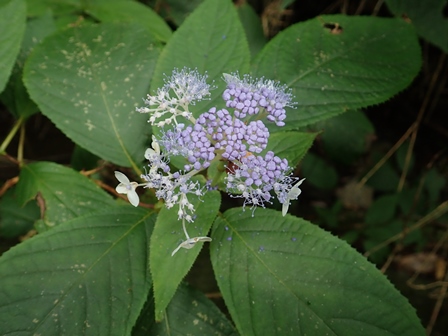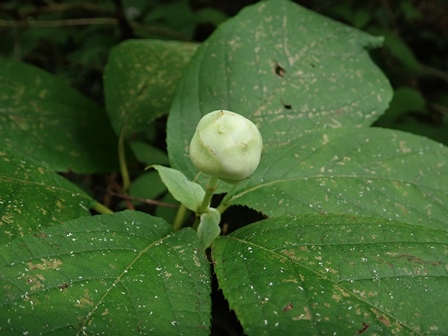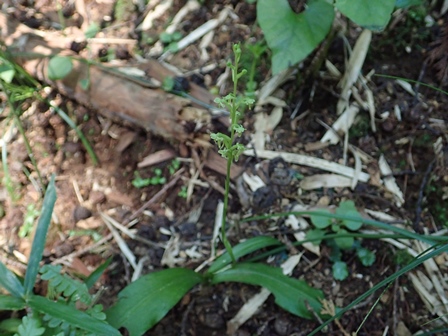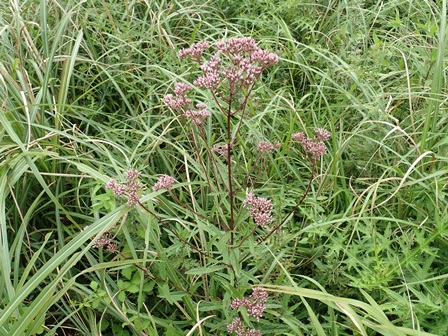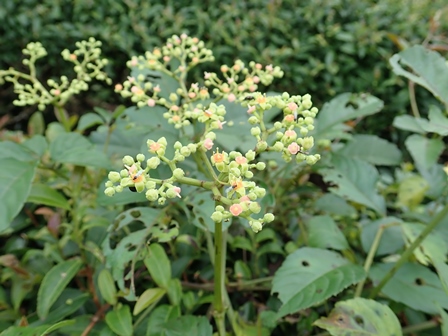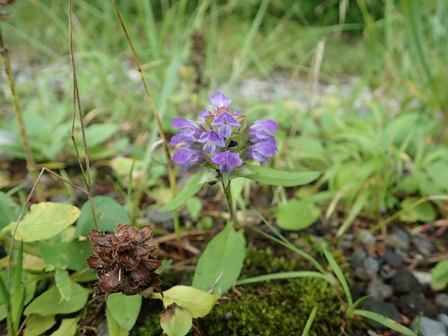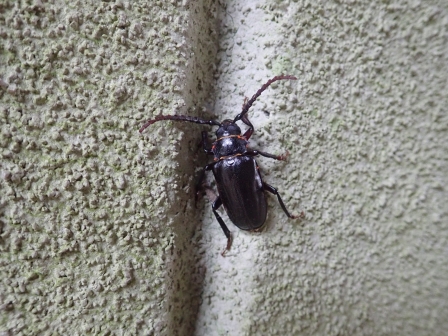フィールド日記
2020年08月
2020.08.31
8月の野鳥の調査
日本野鳥の会東富士副代表の滝道雄先生が8月の不二聖心の野鳥について調査をしてくださいました。調査の報告書が届きましたので、掲載いたします。
2020年8月度の調査で確認された野鳥は下記の通りです。
1.キジバト…3羽
2.トビ…1羽
3.アオゲラ…1羽
4.ハシブトガラス…2羽
5.シジュウカラ…2羽
6.ツバメ…3羽
7.ヒヨドリ…6羽
8.ウグイス…1羽
9.メジロ…6羽
10.カワラヒワ…1羽
11.ホオジロ…2羽
12.ソウシチョウ…1羽
【特記事項】
1.盛夏の時期は留鳥と夏鳥のツバメが見られるだけなので、確認された種数は12種類と少ない。
2.2018年、2019年にはヤマアカガエルを見かける事がほぼ無かったが、今回の調査では13匹を確認できた。いづれも体長1cm程度と小さいが、その跳躍距離は長く、約1m程度であった。
2020.08.28
タマアジサイ
裏道の沢沿いでタマアジサイが咲いています。山地の谷間などに見られるアジサイの仲間です。アジサイは梅雨に咲くイメージがありますが、本種の花期は1か月以上遅く、夏から秋にかけて咲きます。
和名は、蕾が球形をしていることに由来します。
"Tamaajisai(タマアジサイ)" trees are in bloom along a stream in the back road. It is a kind of hydrangea that is usually seen in mountain valleys. We have an image that hydrangea blooms during the "Tsuyu" (Japanese rainy season). However, this species, "Tamaajisai", starts to bloom one month later than other species of hydrangea. we can enjoy "Tamaajisai" in summer and even fall.
"Tama(タマ)" in its name means "sphere" and it comes from the shape of its buds.
2020.08.25
アズチグモ
ナンバンギセルの花の中にアズチグモがいました。アズチグモは木や草の花の上に潜んで、花を訪れたハエやチョウなどの昆虫を捕らえます。体色は白や黄色など変異があります。目の部分が逆三角形の形をしているのが特徴です。
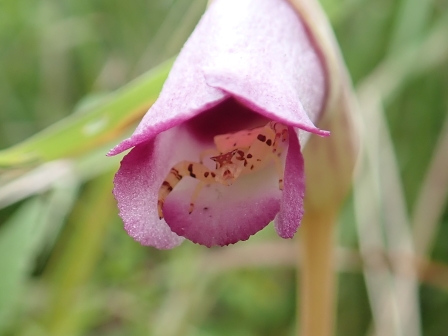
I found "Azuchigumo(アズチグモ)" spider in "Nanbangiseru(ナンバンギセル)" flower. "Azuchigumo" spiders hide in flowers and they wait for their prey like butterflies and flies. We sometimes find different colors of spiders such as white and yellow. One of the characteristics is the triangle shape of their eyes.
2020.08.21
トンボソウ
ヒノキ林の林道でトンボソウが咲いていました。山地の林内に生えるランの仲間です。全体的に小さく、花も緑色であまり目立ちません。

"Tonbosou(トンボソウ)" is in bloom on the path in the Japanese cypress woodland. This is a kind of orchid living in forests. They are small and their flowers are green so they are not showy. However, if you look at the flowers closely, their flowers are typical orchids and have a unique shape. "Tonbo" in its name means "dragonfly" and it probably comes from the shape of the flowers.
2020.08.18
サワヒヨドリ
ススキ野原でサワヒヨドリが咲いています。湿った明るい草地に生える多年草です。ヒヨドリバナに対して湿った環境に生育するためサワヒヨドリと呼ばれるようですが、ススキ野原では両種が混生しています。本校のススキ野原では、ヒヨドリバナに対してサワヒヨドリの花は赤みを帯びていて、花期も若干早いようです。
"Sawahiyodori(サワヒヨドリ)" plants are in bloom in the Japanese grass field. They are perennial plants living in sunny moist grass fields. "Sawa" in its name means "swamp". It is because they prefer moist places compared to "Hiyodoribana(ヒヨドリバナ)" plants, which is similar species to this one. You can see both "Sawahiyodori" plants and "Hiyodoribana" plants in the Japanese grass field. "Sawahiyodori" plants bloom a little earlier than "Hiyodoribana" plants and their flowers are reddish.
2020.08.16
7月の野鳥の調査
2020.08.14
コオニユリ
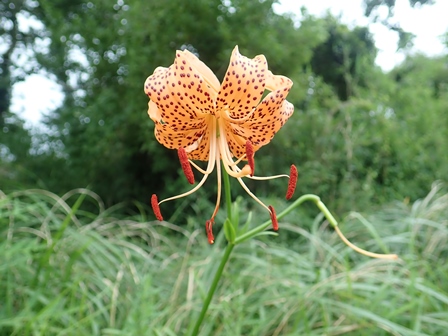
2020.08.11
ヤブカラシ
お茶畑でヤブカラシが咲いていました。いたるところで繁茂していて、まさに藪を枯らしてしまうほどの勢いです。花は蜜を分泌していて、多くの虫たちが集まっていました。しかし、東日本で見られるヤブカラシは三倍体と呼ばれる個体で、ほとんど実をつけることはないようです。
"Yabukarashi(ヤブカラシ)" plants are in bloom in the tea fields. "Yabukarashi" means "to kill bushes". Actually, they are flourished as if they were killing bushes. Their flowers have produced nectar and many insects are coming to the flowers. However, "Yabukarashi" plants that grow in Eastern Japan are botanically called "triploid" and they seldom produce their fruits.
2020.08.07
ウツボグサ
第一オークヒルでウツボグサが咲いています。日当たりの良い草地や路傍に生える多年草です。
花後、花穂は枯れて茶色くなります。この姿が矢を入れる容器である靭(うつぼ)に似ているので、ウツボグサと呼ばれています。
"Utsubogusa(ウツボグサ)" is in bloom in the First Oak Hill. It is a perennial plant living in sunny grass fields and road sides.
After flowering, its spike dies and turns brown. The shape of dead flowers looks like a case for arrows that is called "Utsubo(靭)". That is why it is named "Utsubogusa".
2020.08.04
ノコギリカミキリ
校舎の壁にノコギリカミキリがとまっていました。ここには外灯があり、夜のうちに様々な昆虫が集まってきます。和名は、ギザギザのある触覚に由来します。針葉樹から広葉樹まで幅広い木材を餌とします。
I found this long-horned beetle called "Nokogirikamikiri(ノコギリカミキリ)" on the wall of our school building. During the night, many kinds of insects come to the outside lights of school building . "Nokogiri(ノコギリ)" in its name means "saw" and it comes from their sawtooth-like jagged antennae. Their larvae eat wide variety of trees from conifers to broadleaf trees.
- 1 / 1


